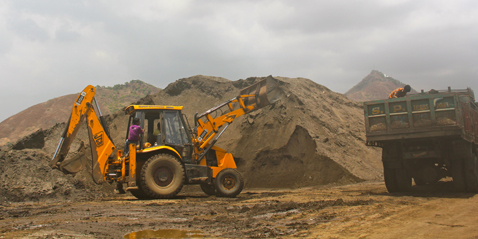
Following a Supreme Court order in February 2012 requiring that leases of minor minerals including their renewal for an area of less than five hectares be granted by state governments only after getting environmental clearance from the Ministry of Environment and Forests, states like Maharashtra and Madhya Pradesh are witnessing a spurt in cases of illegal mining of minor minerals, particularly sand.Though mining of sand comes within the purview of state governments, the growing menace of illegal sand mining in various parts of the country had been discussed during recent meetings of the Parliamentary Standing Committee on Water Resources as well as the Committee on Steel and Mines.
In October, the Ministry of Mines held a three-day meeting under the chairmanship of Mines Secretary Dr. Anup K. Pujari with Principal Secretaries and Secretaries in charge of mines in states to discuss the issue of illegal sand mining. The objective of the meeting was to deliberate and find ways and means that could help state governments curb illegal sand mining. States that participated in the meeting included Andhra Pradesh, Madhya Pradesh, Tamil Nadu, Odisha, Maharashtra, Telangana, Rajasthan, Gujarat, Chhattisgarh, Karnataka, Jammu & Kashmir, Arunachal Pradesh, Himachal Pradesh, Kerala, Jharkhand, Punjab and Meghalaya.
During the meeting with the representatives of the state governments, officials from Maharashtra and Madhya Pradesh said the requirement of obtaining environmental clearance as mandated in the Supreme Court order had led to a rise in cases of illegal mining of minor minerals, especially sand. The process of obtaining environmental clearance, they pointed out, involved various stages and was difficult.
After listening to the views of state governments, the Ministry of Mines felt that the Supreme Court needs to be approached for seeking a clarification on whether the requirement of obtaining environmental clearance was a permanent obligation or only a transitory requirement till the time all states framed rules under Section 15 of the Mines and Minerals (Development and Regulation) Act.
The Supreme Court order required state governments to frame such rules taking into consideration the recommendations made in the MoEF report of March 2010 and the model guidelines framed by the Ministry of Mines. The MoEF and the Ministry of Mines now plans to file an interlocutory application seeking clarification in this regard before the Supreme Court.
States have adopted different measures to govern sand mining based on geomorphology, prevailing socio-economic conditions, demand for sand and strength of administrative machinery. In almost all states, however, litigation is creating hurdles in grant and renewal of sand mining leases. While many state governments already have regulatory mechanisms for sand mining in place, others are in the process of evolving a sand mining policy subsequent to the Supreme Court order.











